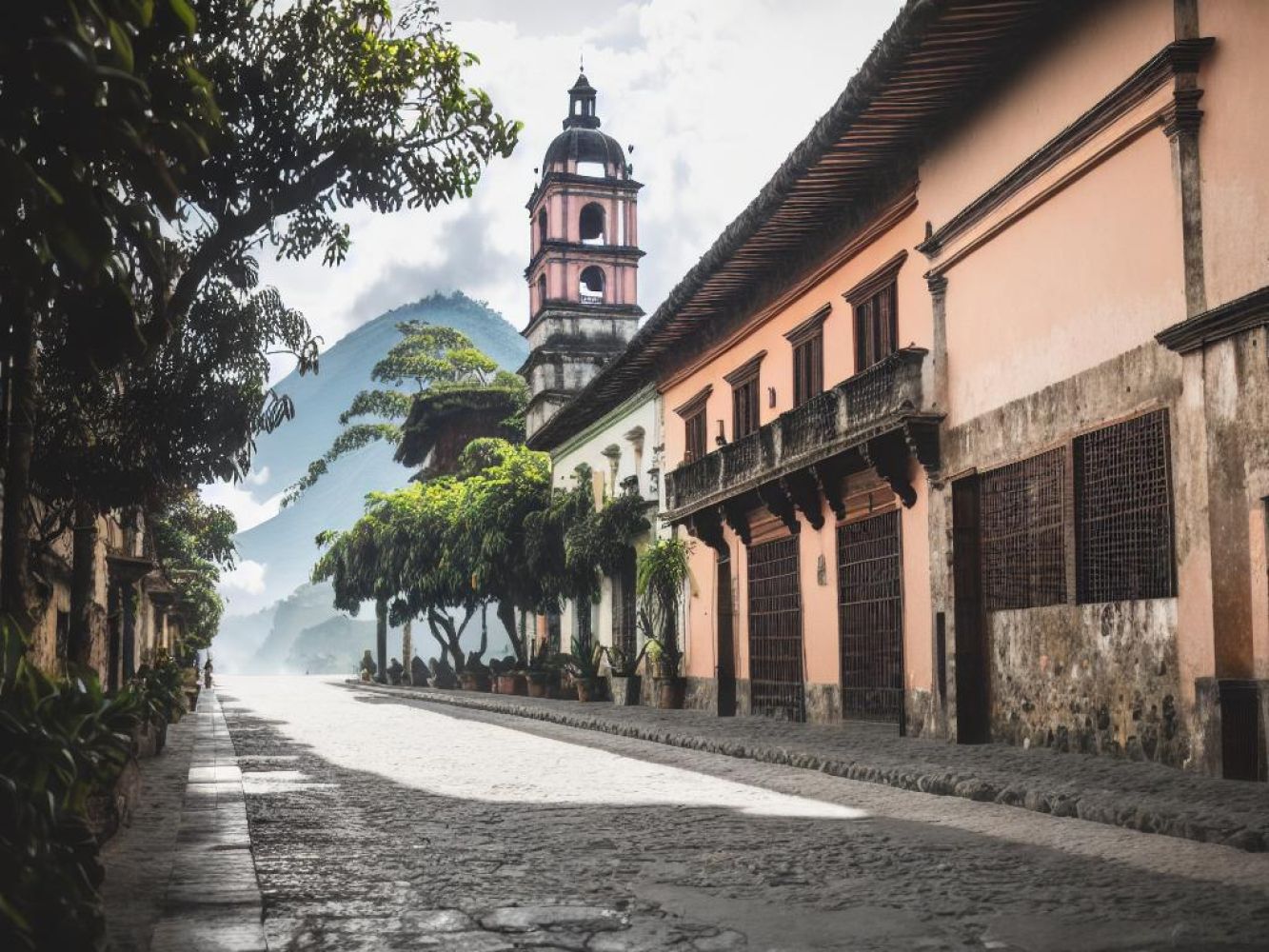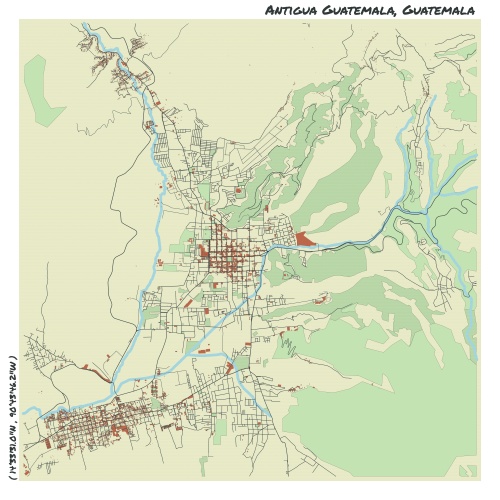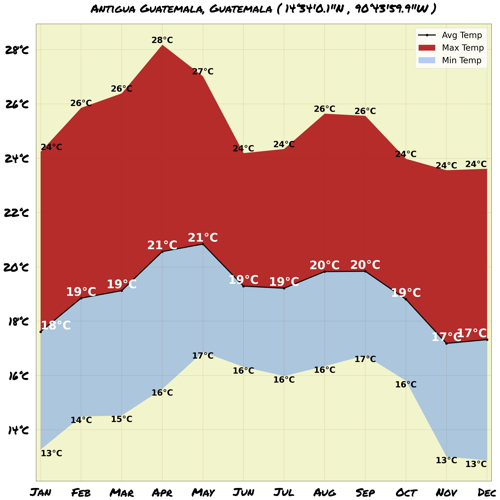Understand
From its historical roots as the capital of the Spanish colony of Guatemala, Antigua has evolved into a captivating city with a rich cultural heritage. Once known as La Muy Noble y Muy Leal Ciudad de Santiago de Los Caballeros de Guatemala, Antigua's past is intertwined with the ancient Maya capital of Iximche and the Volcan de Agua. After Iximche rebelled against the Spanish, the capital was moved to the area near the Volcan de Agua, known as Ciudad Vieja. However, a catastrophic collapse of the volcano's crater led to the destruction of the city by flooding. In 1543, Antigua was established as the new capital and remained so until a devastating earthquake struck in 1773, resulting in extensive damage. The Spanish Crown then ordered the capital to be relocated, leading to the birth of modern Guatemala City, known as "Nueva Guatemala de la Asuncion." Antigua gradually transformed from a bustling capital to a provincial town, now affectionately called "Antigua Guatemala" or "Old Guatemala." Throughout the 20th century, Antigua gained recognition for its exceptionally preserved colonial Spanish architecture. Efforts to develop the city for tourism flourished, culminating in its designation as a UNESCO World Heritage site in 1979. Antigua's streets are laid out in a rectangular grid, anchored by the Parque Central as the starting point. The north-south roads, called avenidas or avenues, are numbered from east to west, further divided into "sur" (south) and "norte" (north). The east-west roads, known as calles or streets, are numbered from north to south, with subdivisions of "oriente" (east) and "poniente" (west). This division originates from the intersection at the Palace of the Captains-General, near the southeast corner of Parque Central. As you navigate the city, you may encounter some roads that deviate from the numbering scheme, especially away from the center. Most street corners lack signs indicating the names of the intersecting streets. The city's streets are cobblestoned, and the sidewalks may not always be in the best condition. Addresses follow a sequential numbering system from the starting point. Even-numbered addresses line one side of the street, while odd numbers occupy the other side. A typical address includes the street or avenue number followed by the abbreviation "av." (avenida) or "Cle / C." (calle), along with directional indicators such as "ote" (oriente, east), "pte" (poniente, west), "sur" (south), or "nte" (norte, north). For instance: - "5a av. nte #5" represents address number 5 on 5th Avenue North, slightly to the north of the dividing street, 5a calle. - "3a calle ote #28" indicates address number 28 on 3rd Street East, located east of the east-west divider, 4a Avenida. Remember that Parque Central serves as the point of reference for north, south, east, and west in street addresses. The north and south sides of Parque Central are marked by 4a and 5a calles, respectively, while the west and east sides are defined by 5a and 4a avenidas. Once you understand the orientation in relation to Parque Central, navigating the city becomes more manageable. Don't forget to pay a visit to the Inguat Tourist Office, conveniently located at 2a Calle Oriente #11 (between Avenidas 3a and 2a). They are available Monday to Friday from 8AM to 5PM and on weekends from 9AM to 5PM. Feel free to reach them at 7832-3782 for any assistance you may need during your stay in Antigua.
Get in
Ready to embark on a journey to Guatemala City? Located just 30 minutes (45 km) west of the city, you can conveniently arrive at your destination in 45-60 minutes from La Aurora Airport. There are multiple transportation options to choose from, so you can find the one that suits you best. If you're feeling adventurous, you can catch a crowded chicken bus (a reused U.S. school bus) from Guatemala City for only Q20. Although there have been incidents of violence, many still consider the chicken buses and local city buses in Antigua to be safer than other transport options like taxis or tuk-tuks (small three-wheelers with cloth side doors). However, when safety is a top priority, it's recommended to call a cab company or prearrange your rides through a shuttle company. For a more comfortable and convenient option, there are regular shuttle vans directly from the airport to Antigua. These shuttles cost around Q80 and leave regularly throughout the day until 8PM. It's advisable to pre-purchase tickets from a local travel agent to secure your spot, especially during peak travel times. If you prefer a taxi, you can expect to pay around Q350 for a ride from the airport to Antigua. Consider sharing the taxi with 2 or 3 other passengers to make it more affordable and comparable to privately arranged shuttles. If you're already in Copn, Honduras, there's a direct shuttle bus that departs twice a day at 5:30 AM and noon. You can also opt for a charter tourist van, which costs about Q250 to Q350. The driver will meet you at the airport with a sign bearing your name. This option provides convenience and security, especially for first-time visitors. While taking the bus may be a cheaper alternative, it's important to note that it's less convenient and may take longer. If you're heading to Antigua, you'll need to take a cab to the second-class bus station that operates this route and then hop on a chicken bus. Keep in mind that there is no commercial air or train service available for this town. However, if you're coming from Panajachel, there is a direct chicken bus (camioneta) to Antigua, operating Monday to Saturday. On Sundays, there is a chicken bus that leaves from the fire station at 10am, with a necessary change in Chimaltenango. The fares for this trip are Q25 for the first leg and Q5 for the second leg. Make sure not to miss out on these convenient transport options!
Map & Climate
Popular Foods
 Dish: PupusasPupusas are thick, round corn tortillas filled with cheese and often accompanied by various meats such as pork, chicken, or beef. These savory treats can be found throughout Guatemala and are typically served as a snack or light meal. They are cooked on a griddle until golden brown and often enjoyed with a side of curtido, a tangy cabbage slaw.
Dish: PupusasPupusas are thick, round corn tortillas filled with cheese and often accompanied by various meats such as pork, chicken, or beef. These savory treats can be found throughout Guatemala and are typically served as a snack or light meal. They are cooked on a griddle until golden brown and often enjoyed with a side of curtido, a tangy cabbage slaw. Dish: TamalesTamales are a traditional Guatemalan dish consisting of masa (a type of dough made from ground corn) stuffed with various ingredients such as meat, vegetables, or fruits, then steamed in corn husks. The result is a delicious, compact package of flavor that showcases the diverse culinary heritage of the country. Tamales can be enjoyed as a main course or as a tasty snack, depending on their filling and size.
Dish: TamalesTamales are a traditional Guatemalan dish consisting of masa (a type of dough made from ground corn) stuffed with various ingredients such as meat, vegetables, or fruits, then steamed in corn husks. The result is a delicious, compact package of flavor that showcases the diverse culinary heritage of the country. Tamales can be enjoyed as a main course or as a tasty snack, depending on their filling and size. Dish: Chiles RellenosChiles Rellenos are whole, roasted poblano peppers that are stuffed with a mixture of cheese and meat, then battered and deep-fried until crispy on the outside. This indulgent dish is a favorite across Guatemala and often served as a main course. The flavors and textures combine perfectly – the slightly smoky pepper, the gooey melted cheese, and the tender pieces of meat create a symphony of taste that represents the essence of Guatemalan cuisine.
Dish: Chiles RellenosChiles Rellenos are whole, roasted poblano peppers that are stuffed with a mixture of cheese and meat, then battered and deep-fried until crispy on the outside. This indulgent dish is a favorite across Guatemala and often served as a main course. The flavors and textures combine perfectly – the slightly smoky pepper, the gooey melted cheese, and the tender pieces of meat create a symphony of taste that represents the essence of Guatemalan cuisine.




Comments
NO COMMENTS